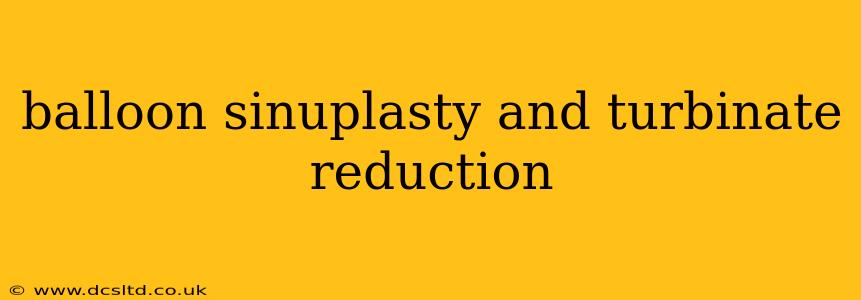Sinusitis, or inflammation of the sinuses, can significantly impact your quality of life. While traditional treatments exist, balloon sinuplasty and turbinate reduction offer minimally invasive alternatives with potentially faster recovery times. This comprehensive guide will delve into these procedures, comparing and contrasting them, and answering frequently asked questions.
What is Balloon Sinuplasty?
Balloon sinuplasty is a minimally invasive procedure used to treat chronic sinusitis. It involves inserting a small balloon catheter into the blocked sinus passage. The balloon is then inflated to widen the opening, improving drainage and airflow. This helps to alleviate sinus pressure, pain, and congestion. The procedure is often performed under local anesthesia and typically takes less than an hour. It's a less aggressive approach compared to traditional sinus surgery.
What is Turbinate Reduction?
The turbinates are bony structures covered with mucous membranes inside your nasal passages. They help filter and humidify the air you breathe. However, enlarged or inflamed turbinates can obstruct airflow, leading to nasal congestion and breathing difficulties. Turbinate reduction aims to reduce the size of these structures, improving nasal breathing. This can be achieved through various methods, including surgical removal (partial or complete turbinectomy), radiofrequency ablation, or coblation. The choice of method depends on the individual's specific needs and the extent of turbinate enlargement.
Can Balloon Sinuplasty and Turbinate Reduction be Performed Together?
Yes, balloon sinuplasty and turbinate reduction are often performed together, especially in cases where both sinus blockage and enlarged turbinates contribute to nasal congestion and breathing problems. The combined approach can provide more comprehensive relief and improve long-term outcomes. The surgeon will determine the best course of action based on a thorough evaluation of the patient's condition.
What are the Risks and Complications of Balloon Sinuplasty and Turbinate Reduction?
Like any surgical procedure, both balloon sinuplasty and turbinate reduction carry potential risks and complications, although these are generally considered low. Possible complications include bleeding, infection, and persistent or recurrent symptoms. However, these complications are relatively uncommon with skilled surgeons using modern techniques. It's crucial to discuss the potential risks with your doctor before undergoing any procedure.
How Long is the Recovery Time for Balloon Sinuplasty and Turbinate Reduction?
Recovery times vary depending on the individual and the extent of the procedure. Balloon sinuplasty typically involves a shorter recovery period, often allowing patients to return to normal activities within a few days. Turbinate reduction, especially surgical reduction, may require a slightly longer recovery period, possibly up to several weeks. Your doctor will provide specific instructions regarding post-operative care and expected recovery time.
What are the Alternatives to Balloon Sinuplasty and Turbinate Reduction?
Several alternatives exist for treating chronic sinusitis and nasal congestion, including:
- Medical Management: This involves using medications such as nasal corticosteroids, decongestants, and antibiotics to manage symptoms.
- Functional Endoscopic Sinus Surgery (FESS): This is a more invasive surgical approach compared to balloon sinuplasty, involving the removal of inflamed tissue and improving sinus drainage.
Which Procedure is Right for Me?
The best procedure depends entirely on individual circumstances. A consultation with an ENT specialist is essential to determine the most suitable treatment option. Factors such as the severity of your symptoms, the location and extent of blockage, and your overall health will be considered. Your doctor will carefully evaluate your condition and discuss the benefits, risks, and alternatives to help you make an informed decision.
What is the Cost of Balloon Sinuplasty and Turbinate Reduction?
The cost of these procedures can vary significantly depending on factors such as location, the surgeon's fees, and the extent of the procedures needed. Insurance coverage may also influence the out-of-pocket expenses. It's essential to discuss the costs with your doctor and insurance provider before scheduling the procedures.
This information is for educational purposes only and should not be considered medical advice. Always consult with a qualified healthcare professional for diagnosis and treatment of any medical condition.
